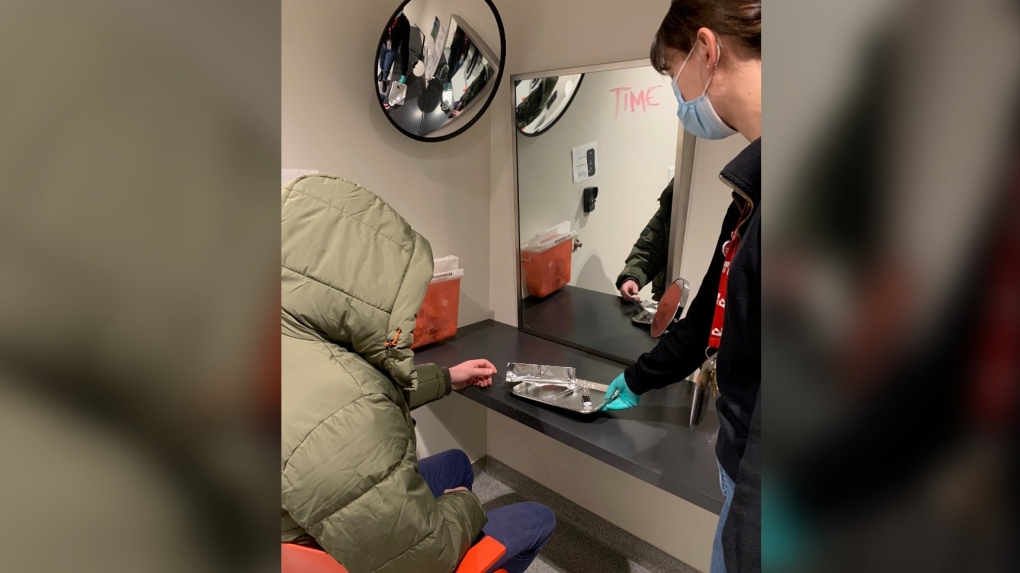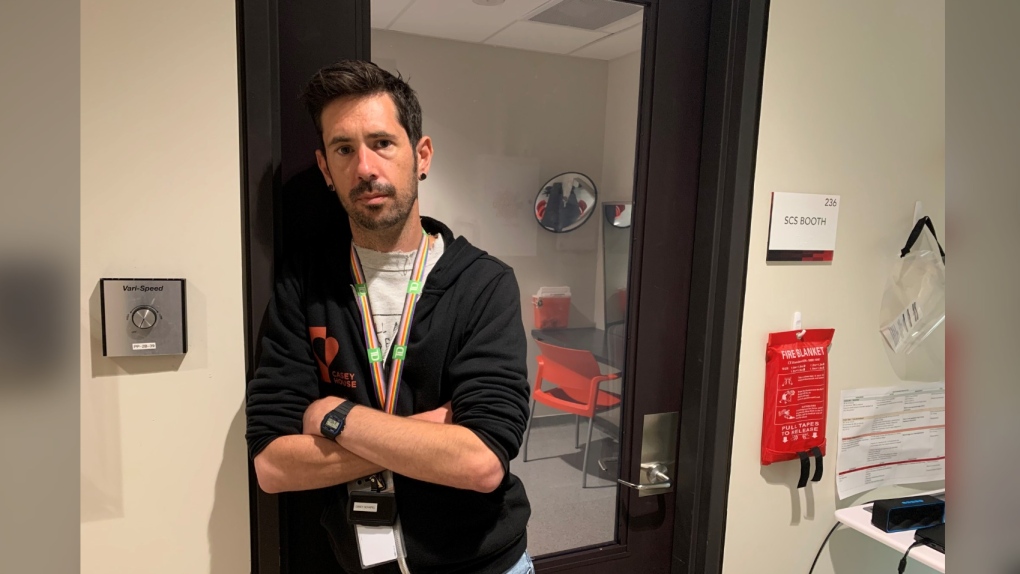Ontario's first supervised drug inhalation service opens in Toronto amid rise in smoking-related OD deaths
 A photo of a client and a health care worker inside the newly opened drug inhalation booth at downtown Toronto's Casey House (Casey House photo)
A photo of a client and a health care worker inside the newly opened drug inhalation booth at downtown Toronto's Casey House (Casey House photo)
For the first time in Ontario, people who choose to inhale their substances now have a safe, indoor space to go.
Toronto’s Casey House has now added drug inhalation to the list of services it offers through its supervised consumption service.
The hospital’s new inhalation booth opened last month and is currently available from 10 a.m. to 4 p.m. daily to all registered Casey House clients.
This new service comes as Toronto deals with a recent rash of drug smoking-related overdose deaths.
Just last week, the city's health unit issued a drug alert after paramedics responded to nine suspected opioid overdose deaths involving inhaled substances between Dec. 5 and 11.
Back in July, Toronto Public Health warned the public after 10 people died of a suspected opioid overdose between July 17 and July 21. It attributed that loss of life to a “potential increase of smoking opioids and stimulants” as drug inhalation equipment, like pipes, were found at the scene of a number of the deaths.
Joanne Simons, Casey House’s CEO, said she and her team have been working for about five years to offer supervised drug inhalation, which she said came at the asking of their patients/clients.
In August 2021, the downtown Toronto hospital became the first one in Ontario to offer supervised consumption services (SCS) for inpatients when it opened a small space on its third floor for people to inject, snort, or ingest their substances.
Casey House expanded its SCS to include outpatient clients last April when it opened a new space on the second floor with three booths, including an inhalation room for people who choose to smoke their drugs.
Red tape, however, prevented the inhalation space from being used.
Simons said initially Casey House believed it couldn’t open the inhalation booth due to the Smoke–Free Ontario Act, which prohibits smoking or vaping in enclosed public places and other designated places throughout the province. Upon further investigation, that legislation was found to not include supervised inhalation.
Instead, the roadblock lied in ensuring the space complied with the Occupational Health and Safety Act, Simons said.
“We had no clear specifications on how to operate an inhalation site from the federal or provincial government. … There were no real guidelines,” she told CP24.com.
After working with engineers and consulting with organizations in Saskatchewan and Yukon that currently offer supervised inhalation, Casey House said it constructed its booth with the highest ventilation standards available.
“We can ventilate our room in seconds if a person needs help,” Simons said, adding they presented their technical specifications to the province about a year ago and after much back and forth, got the go-ahead last June to start offering supervised inhalation.
After a few months of preparation, including testing and training staff, the new service at Casey House opened on Nov. 16.
“Taking the time to do this right was important to us,” said Casey Schapel, the hospital’s harm reduction coordinator.
“This isn’t just about making a space in a hospital for people to smoke their substances. This is a chance to show that (supervised inhalation) can be done and it can be done safely.”
 Casey Schapel, Casey House’s harm reduction coordinator, stands in front of the hospital’s new – and as-of-yet unused – inhalation booth.
Casey Schapel, Casey House’s harm reduction coordinator, stands in front of the hospital’s new – and as-of-yet unused – inhalation booth.
Simons said despite the delays, the province has been supportive.
“They wanted to see this initiative move forward,” she said, adding she’s hopeful that the opening of the inhalation service at Casey House is a recognition that it is a genuine health care treatment.
“I’m also hopeful the province will think about how to expand (this service) to its Consumption and Treatment Services (CTS).”
Currently in Ontario, the provincially-funded CTS program does not include supervised inhalation services.
Casey House, however, does not rely on money from the province to run its SCS.
Simons said they have and will continue to share their best practices and data with the province in the hope that it will be used to inform future supervised inhalation programs in Ontario.
CP24.com sent a lengthy list of questions to the Ontario Ministry of Health to better understand why and how the province came to approve Casey House’s drug inhalation service as well as if there’s a possibility that this program will be expanded to other locations in Ontario.
We also asked the ministry if the provincial government is considering allowing its CTS programs to offer drug inhalation, but did not receive a clear answer.
“The supervised consumption site at Casey House is authorized under the Health Canada federal exemption and is not funded by the Ontario Consumption and Treatment Services (CTS) funding program, Casey House did not apply to the CTS program,” spokesperson Bill Campbell wrote in an email.
CTVNews.ca Top Stories

Sparks fly as MPs question minister on pension implications of proposed election date change
Sparks flew at a parliamentary committee Thursday as MPs questioned Canada's democratic institutions minister about a widely opposed provision in electoral reform legislation that seeks to delay the next fixed election date by one week.
'There is no electricity': Canadian travellers in Cuba urge caution in hurricane's wake
Cuba's power grid was knocked out by Hurricane Rafael, which ripped across the country as a Category 3 storm. In western Cuba, it toppled buildings and pushed 50,000 people to find shelter elsewhere. Cubans were already enduring rolling blackouts due to energy shortages.
Three charged in One Direction singer Liam Payne's death
Three people have been charged in relation to One Direction singer Liam Payne's death in a fall from his Buenos Aires hotel balcony last month, Argentine authorities said on Thursday.
RCMP already 'on high alert' for potential wave of migrants after Trump election
Canada's federal police force has been preparing for months on a contingency plan for a potential massive influx of migrants across the border following Trump's promise of 'mass deportations' of millions of undocumented immigrants in the U.S.
'There was no stopping this baby from coming': Woman gives birth while aboard Newfoundland ferry
A young family from Codroy Valley, N.L., is happy to be on land and resting with their newborn daughter, Miley, after an overwhelming, yet exciting experience at sea.
Volkswagen models recalled for airbag safety precaution
Recall notices have been issued for some Volkswagen models from 2006 to 2019 for airbag safety issues.
Canmore wildlife and landscape defender Karsten Heuer dies peacefully at 56
Canmore conservationist Karsten Heuer, who was a biologist, park ranger, author and activist, has died.
America votes: How celebrities are reacting to Trump's decisive victory
Celebrities from Hulk Hogan to Ariana Grande are sharing their reactions to the U.S. election, which will see Donald Trump return to the White House.
3 Winnipeg police officers charged with breach of trust, theft
Three members of the Winnipeg Police Service have been charged with breach of trust, obstruction of justice and theft following a lengthy investigation

































